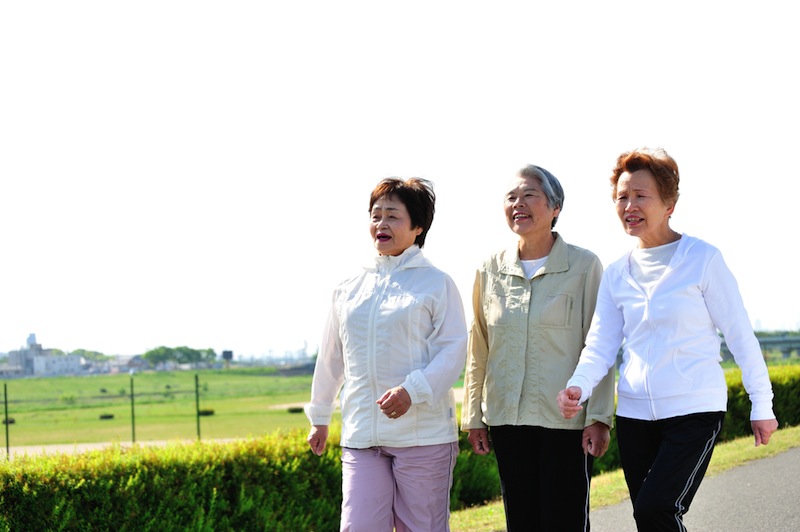Even a Little Walking Can Improve Your Health, Study Suggests

Want to reduce your risk of dying at a young age? Try walking casually for as little as 2 minutes per hour.
While it is well known that intense exercise can help you get fitter, a new study has found that even a little exercise can still go a long way. Study participants who traded time on the sofa for a total of 30 minutes of walking during the day reduced their risk of dying over a three-year period by 33 percent.
For the participants with chronic kidney disease, the risk of dying was reduced by more than 40 percent, according to the findings, published today (April 30) in the Clinical Journal of the American Society of Nephrology.
The Physical Activity Guidelines for Americans, a complement to the government's diet guidelines, recommend that people do at least 75 minutes of high-intensity aerobic physical activity (such as running, swimming or biking), or 150 minutes of moderate-intensity activity (such as brisk walking) every week to reduce the risk of obesity, diabetes and other chronic diseases.
But the researchers on the new study wanted to know what the minimum threshold was — the lowest amount of physical activity that could still provide health benefits, said Dr. Srinivasan Beddhu, a kidney specialist at the University of Utah School of Medicine in Salt Lake City and lead author of the new study. [How Many Calories Am I Burning? (Infographic)]
"We know prolonged sitting is associated with poor [health] outcomes," Beddhu told Live Science. "This study specifically looked at what intensity of activity should be used to replace sedentary activity. The term 'sedentary activity' might sound like an oxymoron, but being sedentary is an active choice to indulge in activities that barely raise the energy expenditure above basal metabolic rate."
That threshold of intensity, Beddhu said, appears to be low. The study found that "light-intensity activities," such as casual walking, are beneficial. In contrast, activities that are "low intensity," such as standing or writing at a desk, aren't enough to provide any meaningful health benefits, the study found.
Get the world’s most fascinating discoveries delivered straight to your inbox.
For this study, Beddhu and his colleagues at the University of Utah and the University of Colorado used information from the National Health and Nutrition Examination Survey, which includes data collected from an accelerometer, a device that measures motion. This enabled the researchers to study the activities of more than 3,600 adults representing the general U.S. population, including 383 adults with chronic kidney disease.
Over the course of three years, 137 of these participants died as a result of various causes. In general, those who exercised more were less likely to die during the study period.
Positive effects of exercise could be seen down to the level of 30 minutes per day of any kind of light activity. Beddhu said that, from the data obtained in the study, he could not discern the precise nature or duration of this light activity, but he surmised that it could be attained merely by getting up to move around a few minutes every hour. The finding could be particularly beneficial for people with kidney disease, who tend to be sedentary and inactive throughout most of the day, Beddhu added.
The latest analysis supports the results of previous studies on the perils of inactivity. For instance, a finding published by researchers at the Pennington Biomedical Research Center in Baton Rouge, Louisiana, in 2009 said that longer lengths of sitting were directly proportional to an increased risk of death from cardiovascular disease and most causes of death other than cancer.
Similarly, a study published in 2003 by Harvard researchers in the Journal of the American Medical Association (JAMA) found that each 2-hour increment of daily television watching raised people's risk of obesity by about 25 percent and their risk of diabetes by 15 percent. Walking around the home, however, reduced these risks.
"We are not advocating for a total of 2 minutes per hour of light activity," Beddhu said. "If a person is already doing 10 minutes per hour of light activity, going to 12 minutes per hour might further decrease their mortality risk."
"It was fascinating to see these results because so much of the current focus is on moderate and vigorous activity," Beddhu added. "A lot of little adds up to a lot."
The assumption here, of course, is that those casual walks around the house don't take you to the refrigerator for a snack.
Follow Christopher Wanjek @wanjek for daily tweets on health and science with a humorous edge. Wanjek is the author of "Food at Work" and "Bad Medicine." His column, Bad Medicine, appears regularly on Live Science.

Christopher Wanjek is a Live Science contributor and a health and science writer. He is the author of three science books: Spacefarers (2020), Food at Work (2005) and Bad Medicine (2003). His "Food at Work" book and project, concerning workers' health, safety and productivity, was commissioned by the U.N.'s International Labor Organization. For Live Science, Christopher covers public health, nutrition and biology, and he has written extensively for The Washington Post and Sky & Telescope among others, as well as for the NASA Goddard Space Flight Center, where he was a senior writer. Christopher holds a Master of Health degree from Harvard School of Public Health and a degree in journalism from Temple University.


